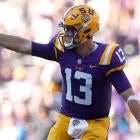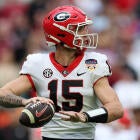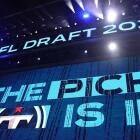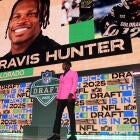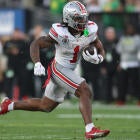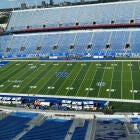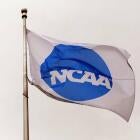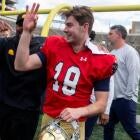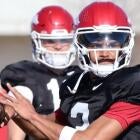
With 150 years of college football in the books -- and with the 151st season in jeopardy because of COVID-19 concerns -- now is as good a time as any to look back. The Big 12 has been at the center of some of college football's biggest moments, from Texas' national championship in 2005-06 over mighty USC, to Oklahoma State nearly crashing the BCS party in 2011. While every program has a different history -- Oklahoma's is as good as any program in college football while Kansas State only started celebrating in the last 20-25 years -- they all have great memories worth revisiting.
Which seasons were the best? We break down each of the Big 12's 10 teams, from Oklahoma to Kansas, and highlight the most memorable years for each of them.
| 2013 | |
| The stretch of 2013-15 was Baylor at its peak under coach Art Briles. Had it not been for injuries at quarterback, the '15 team would have made a claim for the best season ever. However, based on results, I'm going with the one that started it all: 2013. The Bears were slightly more dominant on both sides of the ball (52.4 PPG to 23.5 PPG allowed) and had a number of key players who would return for the 2014 season. It also marked Baylor's first outright conference title since 1980 when it was a member of the Southwest Conference. While the 2014 season was just as good in many respects, Baylor shared its Big 12 title with TCU and came out on the wrong side of the first College Football Playoff debate. But what truly sets the '13 season apart was how unexpected it was. The Bears were not ranked in the preseason polls and picked to finish fifth in the preseason conference media poll. That made the Bears' championship season that much sweeter. | |
| 2017 | |
| Because Iowa State has rarely enjoyed stretches of sustained success, its best season could be viewed through a different lens. The 2000 season, for example, was one of only two nine-win campaigns in program history, with the other one having been more than 100 years ago. However, Iowa State failed to beat a ranked team that year, and in fact lost decisively in the two games against ranked opponents. (It did, however, beat Iowa, which matters.) The 2017 season, on the other hand, saw Iowa State beat not one, but two AP Top five teams -- No. 3 Oklahoma and No. 4 TCU -- in the same month. The Cyclones also reached as high as No. 14 in the AP Top 25 poll. Sure, totality matters. In losing three of the last four regular season games, Matt Campbell's team regressed to the mean a bit. But if the comparison is between a 9-3 and and 8-5 season -- two of the highest win totals for the program ever -- I'll side with the season with the higher peak, recency bias be damned. | |
| 2007 | |
| For some teams, diving into the best season ever requires a lot of thought. This one doesn't. It's 2007 for Kansas and it's not close. In fact, few teams epitomize an entire college football season like the '07 Jayhawks. Recount, if you will, Kansas being ranked No. 2 nationally in a meaningful game against No. 3 Missouri in late November. It was all that separated the Jayhawks from a shot at the Big 12 Championship Game. And recall the time Mark Mangino's team hung 76 whole damn points on Nebraska. The culmination of the magical season was an Orange Bowl victory over Virginia Tech. And while Kansas achieved this unprecedented success with mostly a ragtag group of unheralded recruits, that doesn't mean there wasn't talent on that team. Cornerback Aqib Talib just finished his 13th season in the NFL and was a five-time Pro Bowler. To see the state of Kansas football now makes the '07 season that much more astonishing. | |
| 2003 | |
| When considering Kansas State's best season, there's one window: 1997-2003. Sure, the 2012 Wildcats won a share of the Big 12 championship, but the height of Kansas State as an actual national power under Bill Snyder came in the late 1990s and early 2000s. The choice within this window was much harder. There's a case for the Michael Bishop 1998 team that came oh so close to winning its first Big 12 title and making it to the BCS National Championship Game. However, the Big 12 Championship Game loss to Texas A&M, coupled with the Alamo Bowl loss to Purdue, is too bitter an end to go with the '98 Snydercats. The 2003 season, meanwhile, actually saw Kansas State follow through and win the Big 12 title -- emphatically, over top-ranked Oklahoma, no less. Though the Wildcats had a midseason skid and weren't able to top Ohio State in the Fiesta Bowl, they finally brought a conference title back to Manhattan while running back Darren Sproles led the nation in rushing yards. | |
| 1974 | |
| Where do you begin with Oklahoma? The Sooners are among the most accomplished college football blue-bloods with a plethora of all-time great seasons from which to choose. You could go with one of Bud Wilkinson's teams from the mid 1950s, but therein kind of lies the problem: which one do you choose? Oklahoma won 47 straight games during that era, including 31 straight from 1954-56, which are widely regarded as some of the Sooners' best teams ever. As much as it sounds like a cop-out, it's more practical to go with another year. Enter the 1974 season. Barry Switzer's team absolutely tore through its schedule, beating teams by an average of 34.6 points per game. Other than a three-point win over Texas, no team got within 14 points of Oklahoma. A team that featured eight (8!) All-Americans still holds the NCAA record for most rushing attempts per game at 73.9. While the '74 season did not end in a bowl game, it was the only undefeated team at the end of the season and named national champions. | |
| 2011 | |
| Coach Mike Gundy is responsible for six of the nine 10-plus win seasons in Oklahoma State history. As nice as many of those seasons are, nothing will top the 2011 campaign. The 12-1 Cowboys reached their highest spot ever in the AP Top 25 poll, No. 2, before losing a controversial overtime heartbreaker at Iowa State that eventually cost them a spot in the BCS National Championship Game. Still, the season resulted in Oklahoma State's only Big 12 championship and four victories over ranked opponents, including the Fiesta Bowl over an Andrew Luck-led Stanford and the first win over Oklahoma in nearly a decade. Wide receiver Justin Blackmon also won the Biletnikoff Award for the second straight year while quarterback Brandon Weeden finished second nationally in passing. Would Oklahoma State have won a national title if not for that Iowa State game? It couldn't have been any worse than the Alabama-LSU rematch. | |
| 1938 | |
| You can boil TCU's best season down to two candidates: 1938 and 2010. The answer is probably more of a matter of preference than anything. Do you go with one that actually resulted in a claimed national title (1938) and Heisman Trophy winner (Davey O'Brien)? Or do you go with the one that was top-to-bottom better? Quarterback Andy Dalton remains the program's second-leading passer and the Frogs had the top defense in the nation in 2010 on their way to a Rose Bowl victory over Wisconsin. It's a tough choice, but if the criteria is "best season" and not "best team" then 1938 edges 2010 by a hair. Both squads were unbeaten, but it's hard to argue with a national title and the most prestigious individual award in college football. | |
| 2005 | |
| The national championship winning seasons under Darrell Royal in the 1960s have a claim, but it's impossible not to get lost in the lore of the 2005 season. All year -- or, at least from the moment Texas beat No. 4 Ohio State in Columbus -- the Longhorns were on a collision course with top-ranked USC -- winners of 34 straight -- for the national championship. And what a championship game it was, with Vince Young's go-ahead touchdown in the Rose Bowl to give the Longhorns the BCS title. "Game of the Century" is a liberal moniker, but it's hard to imagine many games, on that stage, in that setting, that were better. That it capped off a perfect season is just the cherry on top. | |
| 2008 | |
| A program's best team often collides with its best season, but what separates the latter from the former are moments, not necessarily talent. However, the two of those were thoroughly intertwined in history on Nov. 1, 2008, when wide receiver Michael Crabtree wrestled away from two Texas defenders on what was basically a walk-off touchdown from quarterback Graham Harrell to take down the No. 1 ranked Longhorns in Lubbock, 39-33. It remains one of the most recognizably clutch plays in the history of the game. Though the Red Raiders were thoroughly outclassed by Oklahoma later that month, they peaked as high as No. 2 in the AP Top 25 poll and finished in a three-way tie for the Big 12 South title. Harrell, now the offensive coordinator at USC, remains Texas Tech's most accomplished passer and 2008 was one of two 11-win seasons for coach Mike Leach, now at Mississippi State. | |
| 1988 | |
| West Virginia has consistently been a decent program with occasional breakthroughs throughout its history. The best examples of these would be the Don Nehlen teams of the late 1980s and early 1990s and the Rich Rodriguez teams of the mid-2000s. Of the bunch, the 1988 season still stands as the best in Mountaineer history. It was, after all, the first Mountaineer team to run the table in the regular season in the modern era. And while Pat White will forever remain West Virginia's most prized and accomplished quarterback, Major Harris was not a force to ignore, either. His injury in the Fiesta Bowl against Notre Dame -- the national championship that season -- goes down as one of West Virginia's biggest "what ifs" ever. However, 1988 did have a massive win over Penn State, 51-30 in Morgantown, for just the second victory over the Nittany Lions in more than 30 years. | |
![[object Object] Logo](https://sportshub.cbsistatic.com/i/2020/04/22/e9ceb731-8b3f-4c60-98fe-090ab66a2997/screen-shot-2020-04-22-at-11-04-56-am.png)


















